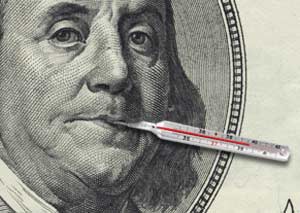 Ever since the Treasury Department under Hank Paulson decided to invest billions in banks across the country, Treasury officials have touted the TARP investments as ways to bolster "healthy" banks during tough economic times. More than 600 banks (and credit card companies and, soon, insurance companies) have received money through the Capital Purchase Program, the first bailout program Treasury launched and still the one representing the largest sum of TARP funds ($134 billion), even after 10 large companies returned $68 billion.
Ever since the Treasury Department under Hank Paulson decided to invest billions in banks across the country, Treasury officials have touted the TARP investments as ways to bolster "healthy" banks during tough economic times. More than 600 banks (and credit card companies and, soon, insurance companies) have received money through the Capital Purchase Program, the first bailout program Treasury launched and still the one representing the largest sum of TARP funds ($134 billion), even after 10 large companies returned $68 billion.
Recipient banks across the country have emphasized that the program is not a bailout for banks. But some of the banks receiving money under the program don't meet a common-sense definition of "healthy." Citigroup and Bank of America, for instance, were among the first banks to receive money, only to need further injections of it later.
Two recent reports call attention to the banks in the program that are struggling despite having received TARP funds.
The Sacramento Bee focuses on one local bank, Community Business Bank, one of the hundreds of community banks that have received TARP funds under $5 million. The Bee found that "those likely to benefit most from the taxpayer-funded windfall are a small group of insiders and their associates," since about one-third of the bank's loans have gone to those insiders, real estate loans that now imperil the bank. The CEO defended the bank's health and practices, saying, "Our lending practices are very good. ... The problem is, the economy sucks."
Separately, the Wall Street Journal reports today that three banks have stopped paying dividends to the government in order to conserve capital. Under the terms of the investments -- in which the government gets paid 5 percent interest annually for the first five years -- the banks can choose to suspend the quarterly payments up to six times. After the sixth payment is missed, the government can appoint two members to the bank's board of directors. (Over all, the Treasury has received about $4.8 billion in dividends from banks in the program. Citigroup and Bank of America have paid an additional $1.1 billion for their extra $40 billion in aid.)
The three banks that recently stopped payment of the dividends, Pacific Capital Bancorp, Seacoast Banking Corp. and Midwest Banc Holdings, are large community banks with TARP investments ranging from $181 million to $50 million. One equity analyst told the Journal that the decisions to suspend dividends surprised him and shows that Treasury did not adequately vet the banks receiving funds under the program.
But there is evidence that regulators knew some of the banks were on shaky ground even before the banks received funds. In the case of Seacoast, for example, the bank disclosed when it received TARP funds last December that it had reached an agreement with its primary regulator, the Office of the Comptroller of the Currency, to devise a strategy to diminish its exposure to risky assets. Recently, Seacoast said it had suspended dividends to the government on the basis of advice from the Federal Reserve. The bank emphasized that it remained "well capitalized" by regulatory guidelines.
A recent report from the Goverment Accountability Office said that 17 banks did not pay a dividend in May, most because state or federal regulations prohibited declaring dividends. One bank told Treasury it was because the bank was worried about its profitability. Three banks provided no explanation. All told, banks have missed about $6 million in payments, the GAO said. The report did not identify the banks.


